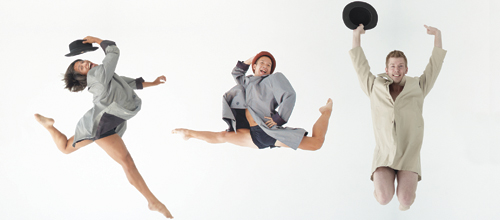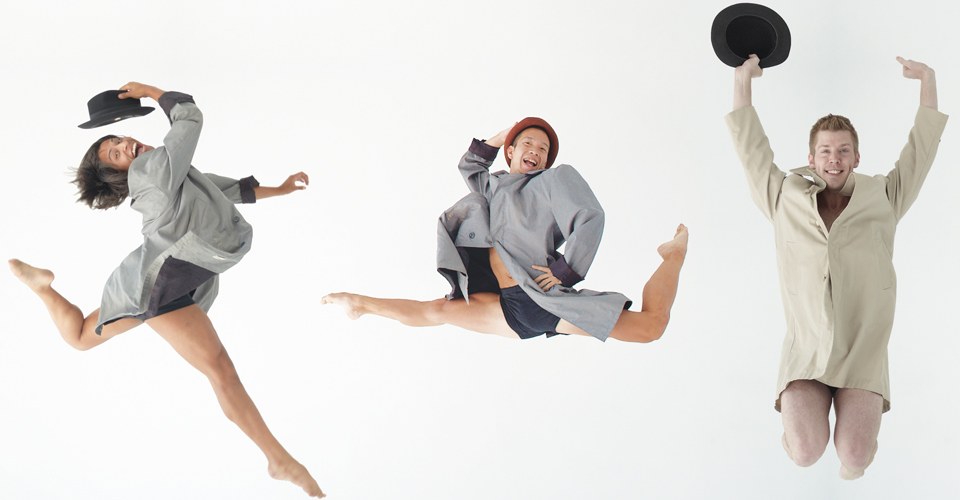
A Texan, a Japanese, and a Mississippian Walk into a Dance Studio

Three men from Hope Stone Dance Company
by Neil Ellis Orts
Photos by Simon Gentry
In anticipation of their next show, I sat down with three dancers from Hope Stone Dance Company who are out gay men—Jesus Acosta, Shohei Iwahama, and Nick Nesmith—to take the temperature of what it means for this generation of men to be gay in the dance world, as well as to find out a little bit about their influences and beginnings as dancers.
Acosta is the only native Houstonian of the three. He cites his first movement experience as a member of the color guard while in high school in Sharpstown, which led to the dance team. It wasn’t until he got to Sam Houston State University—as a history major—that he experienced dance outside of a high school setting. In his second semester, he became a dance major and never looked back.
Iwahama has traveled the greatest distance to dance with Hope Stone, having been born in Tokyo. His older sisters took ballet classes, so he doesn’t remember the first time he was in a dance studio, but as a preschooler, he rejected ballet. “I thought the barre exercises were really boring,” he says. But when he was 15, a friend who was a dancer reintroduced him to dance and he gave it another go, this time in the modern dance idiom. He quickly started winning competitions, eventually getting a government grant to study at the Ailey School in New York before landing in Texas, also at Sam Houston State.
Nesmith comes from Mississippi, where his first performing experience was in community theater and his high school’s show choir, which he describes as “like the Glee thing.” When he went off to college in Alabama, it was as a music major. He missed his song-and-dance experience, however, and auditioned for summer work with Six Flags, ending up in the company of performers at Houston’s now-defunct AstroWorld. By the end of that summer, he decided he wanted to study dance more than piano. Since many of his AstroWorld cohorts were students at Sam Houston State, he decided to enroll there, too, starting him down the path of a dance career.
As Hope Stone is a modern dance company, they spoke about that experience and all agreed that it might be somewhat easier to be out in the modern dance community as opposed to the ballet community.
“It’s really about being yourself,” Acosta says, “and it doesn’t really matter who you are. Especially here at Hope Stone, where everyone is so loving and caring.”
“Differences are more embraced,” Nesmith agreed, “especially here in our community, but probably in modern dance in general.”
Perhaps a more telling sign that sexuality is less of an issue in their community is that when I asked about their gay male role models from previous generations, they seemed stumped to name dancers in particular.
“In terms of sexuality, I think all the experiences that I’ve had includes my ➝ role models,” Iwahama says. “I can’t really name a specific person, but in the community, I just feel it’s okay.”
Having all studied at Sam Houston State, they did have one shared influence who was first named by Nesmith as the other two quickly nodded in agreement.
“In dance training, you always have heroes, and gender or sexuality doesn’t really come into play,” Nesmith says. “But as I’ve gotten a little older, there are people that I worked with who mean so much to me now, and the sexuality does come into play there. They were teaching me dance, but just the experience of knowing that person and being around them at that age . . . the knowledge they passed down to me is really valuable now that I’m not eighteen.”
Here Nesmith names Jonathan Charles, on the Sam Houston State faculty. “My family doesn’t live here, and he’s always kind of been like a parental figure to me. I can go to him for guidance. You know, he danced on Broadway, he went through the AIDS crisis in the ’80s, and he just has so much experience in life. I love being able to sit and talk with him.”
Making a living as a dancer is a piecemeal situation, and all three men have multiple gigs. Both Acosta and Iwahama are in NobleMotion Dance as well as Hope Stone, and they both teach classes around the city. Nesmith picks up gigs with other performance companies like Houston Grand Opera and also plays piano for dance classes.
But this month, it’s all about Hope Stone. When I spoke with them, they had just learned a dance from Hope Stone’s repertoire called “Change Is Inevitable.” In this piece they shake pennies, throw pennies, and generally just fill the stage with pennies. The entire evening is called squared dancer, and is shared with the Houston Metropolitan Dance Company. The Hope Stone dancers still needed to learn a new piece with just their company, as well as a large piece that will be the second act of the evening, integrating both companies’ dancers.
When I asked them if they had anything they wanted to say to the OutSmart audience, they all said together, “Just come see the show!”
Then a beat later, Iwahama struck his best coy pose and said, “Or, ‘Just come see Sho!’”
Squared dancer by Hope Stone Dance and Houston Metropolitan Dance Company will be performed November 9 & 10, 2012, 8 p.m., at the Wortham Center, Cullen Theater. More info: hopestoneinc.org.
Neil Ellis Orts wrote about cartoonist Dylan Edwards in the October issue of OutSmart.










